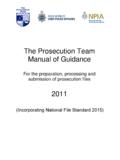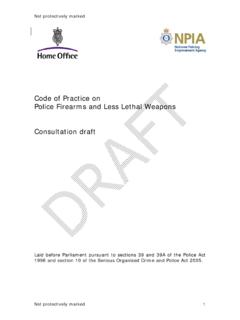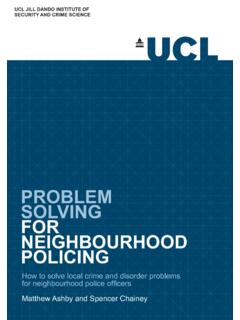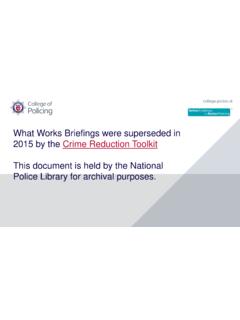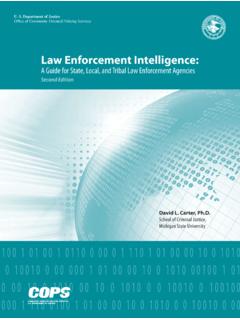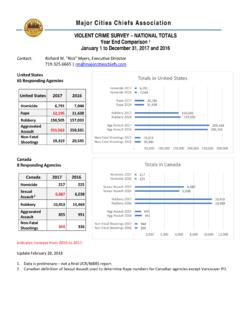Transcription of Women in the police forces in Britain: 1880-1931.
1 UFR d'Etudes Anglophones N d' tudiant : 21408294. Women in the police forces in Britain: 1880-1931. Audrey CARTRON. Master 1 ASPects l'Universit Paris 7-Denis Diderot et l'ENS Cachan M moire de recherche en civilisation britannique Sous la direction de Myriam Boussahba-Bravard Soutenu le 24 juin 2015. Membres du jury : Myriam Boussahba-Bravard et St phanie Pr vost Ann e universitaire 2014-2015. 1/76. Acknowledgments I would like to thank Myriam Boussahba-Bravard, my MA thesis supervisor, for her valuable advice and innumerable comments and Lynn O'Mahony, Assistant Librarian at the UK National police Library, for her help and for the useful documents she sent me.
2 2/76. Table of Contents Table of Contents .. 3. Introduction .. 5. I) Structural obstacles to the recruitment of Women in the police forces : 9. A) A masculine social order: the ideology of separate spheres and of Women 's inferiority .. 9. 1) The theory of separate spheres and its origins .. 9. 2) Patriarchy and Women 's confinement to domesticity and inferiority .. 10. B) Reasons why police jobs were considered as unfit for Women .. 12. 1) Violence, masculinity and police culture .. 12. 2) Incompatibility of everyday life in the police with womanhood and motherhood .. 14. C) When the need for a police female force spread.
3 16. 1) A favourable context: the spread of feminism .. 16. 2) The necessity of Women in an entirely masculine judicial system .. 17. 3) Enough is enough: the Contagious Disease Act, child prostitution and Jack the Ripper .. 18. 1) Family and social background .. 20. 2) Duties .. 21. 3) A parallel between reality and fiction .. 22. II) From matrons to policewomen: 1914-1919 .. 24. A) Two major organisations: the Women police Service and the National Union of Women Workers .. 24. 1) A favourable context .. 24. 2) The creation of the Women police Service and of the National Union of Women Workers's patrols.
4 25. 3) Similarities and 27. B) Policewomen's duties, limited powers and the reactions of the local population .. 30. 1) Munitions factories, patrol work and other duties .. 30. 2) Blurred status and limited 34. 3) The reactions of the local population .. 36. C) Policewomen and feminism .. 39. 1) Testing the boundaries of masculine and feminine and promoting Women 's rights .. 39. 2) Debunking the feminist and revolutionary dimension of Women 's entry into police work .. 41. 3) Policewomen's ambitions for the post-war future and the first encouraging steps .. 43. III) Post-war fight for the official recognition of policewomen: 1919-1931.
5 46. A) Specific work: emphasis on difference .. 46. 3/76. 1) A splitting of feminist ideology in favour of gender difference .. 46. 2) Specialist work .. 47. 3) Their work was not police work, no matter how noble .. 49. B) Ambivalence of the post-war years regarding Women in the police in peacetime .. 51. 1) A certain post-war withdrawal .. 51. 2) A widespread recognition .. 54. 3) The ambivalence of the authorities .. 56. C) Towards a certain acceptance of Women as part of the police organisation .. 60. 1) Policewomen's strategies .. 60. 2) Major changes .. 62. Conclusion .. 65. Appendices .. 67. Bibliography.
6 70. 4/76. Introduction Women are particularly adapted for work which comes outside the scope of the ordinary detective but unfortunately it is sometimes unsafe to trust a woman with an important investigation [or case] where young men are concerned. They are swaged by emotion. They can't help it: it is their nature, and they have been known to fall in love with the man they have been sent to This declaration of a Scotland Yard spokesman in 1916 is one of the innumerable manifestations of hostility endured by Women from the very beginning of their entry into the police . Throughout the end of the nineteenth and the first half of the twentieth century, the campaign for the employment and for the official recognition of policewomen in Britain met with many structural obstacles.
7 Campaigners had to convince sceptical or strongly opposed opponents from society at large but also from within the police forces , which remained for a long time exclusively masculine. police refers to the bureaucratic and hierarchical bodies employed by the state to maintain order and to prevent and detect crime .2 The modern shape of these bodies was designed in 1829 by Robert Peel when he created the Metropolitan police Service, the territorial police force responsible for law enforcement in Greater London. If major changes in the acceptance and the status of Women in the police were experienced and initiated by the Metropolitan police , local variations throughout the country also deserve to be studied.
8 In theory, the Home Office was the head of British police forces but, in fact, it only played and it is still the case today an advisory role. Thus the Home Office had concrete power over the London Force but in the rest of the country the decisions were left in the hands of local authorities. This principle of local discretion was both an advantage and a disadvantage in the fight for the establishment of Women police because, depending on the local chief constables, the idea of the appointment of Women could be either opposed and obstructed or welcomed and actively supported. Hence, this dissertation will focus on Women in the Metropolitan police , and thus in London, but also in forces all over the country in order to tackle the wide range of situations experienced by pioneer policewomen throughout Britain.
9 Besides, the emphasis will largely be put on the campaign for the entry of Women into police work, on institutional changes but also on the in-the-field aspect, tackling the interactions 1. Young, M. (1991). An Inside Job: Policing and police Culture in Britain. Oxford: Clarendon Press, p. 200. 2. Emsley, C. (1991). The English police : a Political and Social History. Hemel Hempstead: Harvester Wheatsheaf, p. 1. 5/76. between Women constables and their male colleagues but also between policewomen and the rest of the society, with who they were directly in contact in the streets for instance. The period 1880-1931 encompasses major improvements regarding the acceptance, role and status of policewomen but also represents a particularly interesting period of British history, especially concerning the evolution of the status of Women in the whole society.
10 Women were first employed by the Metropolitan police as matrons in 1883 thus choosing the year 1880 as a first chronological limit leads me to study a key period of the history of Women in the police in Britain but also to deal with the debate preceding the entry of Women in the police . The year 1931 was marked by a major improvement when the Home Office issued the first official regulations defining the function and the status of policewomen wherever and whenever they were employed. These statutory regulations can be considered as a turning point because they established an institutional framework and were one of the first major steps towards official acceptance of Women into the British police forces .
